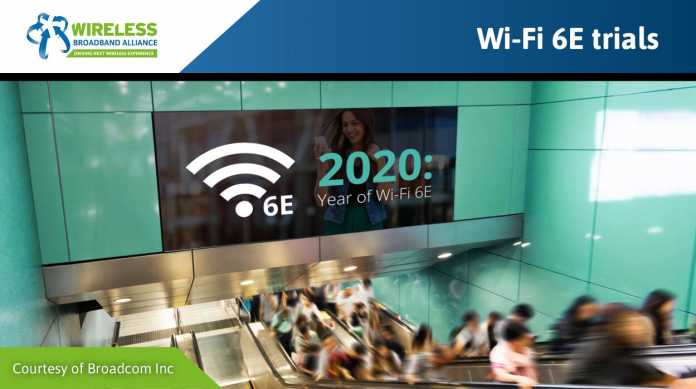Wireless Broadband Alliance (WBA), the worldwide industry body dedicated to improving Wi-Fi services and standards, announced the first phase of Wi-Fi 6E trials showing multi-Gigabit speeds and the low-latency connections required for the next generation of connectivity.
WBA says that opening the 6 GHz band to Wi-Fi 6 technology would remove pain points currently caused by overcrowding on many Wi-Fi networks. The new band will provide more capacity than all the other Wi-Fi bands put together and deliver connections with speeds equivalent to the new advanced 5G mobile networks. Wi-Fi 6E can also support the low-latency levels required for mobile gaming, virtual and augmented reality (VR/AR) applications, and Industry 4.0 solutions.
The trials conducted thus far used Wi-Fi 6E-capable mobile platforms and laptop equipment enabled by WBA member companies, Broadcom and Intel. During the enterprise trials, which took place in San Jose, California, speeds of 2Gbps were achieved, comparable to 5G cellular service speeds, as well as a consistent two-millisecond low-latency connection. The trials showed that Wi-Fi 6E meets the needs of both consumer and industrial VR/AR applications.
Wi-Fi 6E technology is built for performance in congested places like subway stations and WBA will trial these next generation devices in crowded environments. The next stage of Wi-Fi 6E trials is scheduled to take place over the coming months and will include subway transportation systems and in-home testing with CableLabs, SK Telecom and Transit Wireless.
“Wi-Fi 6 networks extended into the 6GHz spectrum represent a multi-generational shift in Wi-Fi services and the user experience,” said Tiago Rodrigues, CEO, WBA. “This trial is an important step in the process of effectively demonstrating the benefits that Wi-Fi networks can deliver in the 6GHz spectrum band. The Wi-Fi 6 standard and the 6GHz spectrum in combination can play a powerful role to deliver advanced mobile services to consumers, business and industry.”
Broadcom and Intel are leading the charge to enable Wi-Fi 6E devices. Broadcom recently announced a broad portfolio of Wi-Fi 6E chips targeted for production later in the year and predict that as many as 500 million Wi-Fi 6E compatible laptops and mobile devices will be in use in the next three years.
“We are excited to enable real world trials conducted by the WBA that demonstrate the power of Wi-Fi 6E,” said Vijay Nagarajan, Vice-President of Marketing at Broadcom. “Wi-Fi 6E will provide reliable high-throughput, low-latency wireless services by deploying Wi-Fi 6 technologies in the soon-to-be-unlicensed and uncongested 6 GHz band.”
Eric Mclaughlin, Vice President Client Computing Group, General Manager Wireless Solutions Group, Intel Corporation said: “Opening the 6GHz spectrum will change the game for Wi-Fi 6 by delivering faster speeds, lower latency, and more reliable connectivity for a wide range of consumer and professional applications. Intel is committed to partnering with the industry to drive innovation and enable leadership connectivity experiences, and we look forward to bringing our Wi-Fi 6E products to Intel PC platforms that can harness the full benefits of the most advanced Wi-Fi technology available.”
Several regulators are working on the possibility to release the 6Ghz spectrum bands for unlicensed use, including FCC in the US, Ofcom in the UK and regulators in the EU, among others. The results of the WBA’s trials and the development of Wi-Fi 6E show ecosystem readiness when this spectrum is released for unlicensed use on an international basis.
Wi-Fi 6E networks bring additional benefits to consumers and enterprises. They support many devices and can provide a low-cost solution to help bridge the digital divide. Wi-Fi 6E can make high-speed Internet services available in rural areas that 5G mobile networks can’t cover cost-effectively. Any community or business with a fixed broadband connection can offer high-speed, high-capacity mobile Internet services over Wi-Fi 6E.
Wi-Fi 6E also overcomes the capacity challenges suffered by many of today’s busiest Wi-Fi hotspots. Current standards require devices to contend for the same shared spectrum, reducing service speeds. Wi-Fi 6E fully-schedules spectrum use and delivers consistent high-speed connectivity to all devices.
Chris Bruce, Managing Director, Global Reach Technology and WBA Board Member said: “Wi-Fi 6 is a step-change in data throughput, network performance and user experience. Wi-Fi 6 and use in the 6 Ghz band in countries where this is made available will only enhance this further. At Global Reach we are delivering Wi-Fi services in high-density transport hub and outdoor city centre environments, where there is typically high footfall, extremely high Wi-Fi authentication volumes and resulting concurrent sessions. Using Wi-Fi 6 technology in these areas will help deliver an excellent experience where large volumes of devices connect seamlessly to the Wi-Fi network using Hotspot 2.0 (Passpoint) technologies.”
Park Jong-kwan, Vice President and Head of 5GX Labs, SK Telecom said: “With increased capacity and throughput, Wi-Fi 6E over 6GHz spectrum will enable new and innovative services for both individual and enterprise customers. SK Telecom will work closely with the Wireless Broadband Alliance and diverse companies across the globe to achieve further innovations.”

